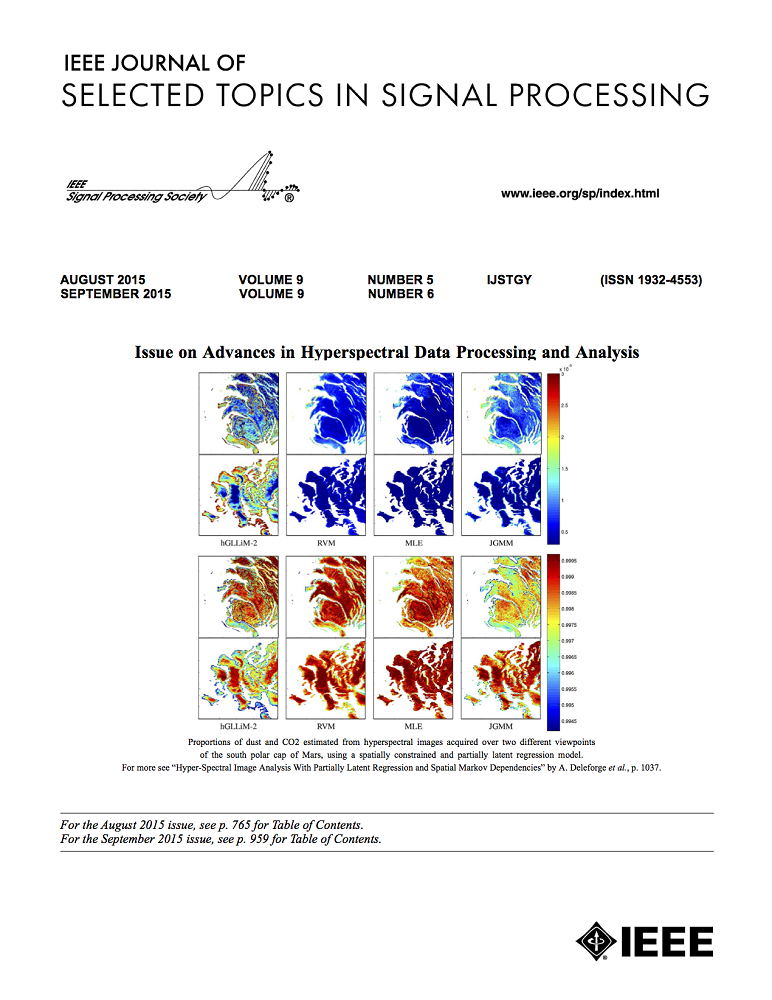Beam-Delay Domain Channel Estimation for mmWave XL-MIMO Systems
IF 8.7
1区 工程技术
Q1 ENGINEERING, ELECTRICAL & ELECTRONIC
IEEE Journal of Selected Topics in Signal Processing
Pub Date : 2024-07-22
DOI:10.1109/JSTSP.2024.3431919
引用次数: 0
Abstract
This paper investigates the uplink channel estimation of the millimeter-wave (mmWave) extremely large-scale multiple-input-multiple-output (XL-MIMO) communication system in the beam-delay domain, taking into account the near-field and beam-squint effects due to the transmission bandwidth and array aperture growth. Specifically, we model spatial-frequency domain channels in the beam-delay domain to explore inter-antenna and inter-subcarrier correlations. Within this model, the frequency-dependent hybrid-field beam domain steering vectors are introduced to describe the near-field and beam-squint effects. The independent and non-identically distributed Bernoulli-Gaussian models with unknown prior hyperparameters are employed to capture the sparsity in the beam-delay domain, posing a challenge for channel estimation. Under the constrained Bethe free energy minimization framework, we design different structures and constraints on trial beliefs to develop hybrid message passing (HMP) algorithms, thus achieving efficient joint estimation of beam-delay domain channel and prior hyperparameters. To further improve the model accuracy, the multidimensional grid point perturbation (MDGPP)-based representation is presented, which assigns individual perturbation parameters to each multidimensional discrete grid. By treating the MDGPP parameters as unknown hyperparameters, we propose the two-stage HMP algorithm for MDGPP-based channel estimation, where the output of the initial stage is pruned for the refinement stage to reduce the computational complexity. Numerical simulations demonstrate the significant superiority of the proposed algorithm over benchmarks with both near-field and beam-squint effects.毫米波 XL-MIMO 系统的波束-延迟域信道估计
本文研究了毫米波(mmWave)超大规模多输入多输出(XL-MIMO)通信系统在波束延迟域中的上行链路信道估计,同时考虑到了传输带宽和阵列孔径增长带来的近场和波束斜效应。具体来说,我们在波束延迟域中建立空间-频率域信道模型,以探索天线间和子载波间的相关性。在这一模型中,引入了频率相关的混合场波束域转向矢量,以描述近场和波束斜效应。采用具有未知先验超参数的独立非同分布伯努利-高斯模型来捕捉波束延迟域的稀疏性,这对信道估计提出了挑战。在受约束贝特自由能最小化框架下,我们设计了不同的试验信念结构和约束条件,开发了混合信息传递(HMP)算法,从而实现了对波束延迟域信道和先验超参数的高效联合估计。为了进一步提高模型精度,本文提出了基于多维网格点扰动(MDGPP)的表示方法,即为每个多维离散网格分配单独的扰动参数。通过将 MDGPP 参数视为未知超参数,我们为基于 MDGPP 的信道估计提出了两阶段 HMP 算法,其中初始阶段的输出被剪枝用于细化阶段,以降低计算复杂度。数值模拟证明,与具有近场效应和波束斜效应的基准相比,所提出的算法具有明显优势。
本文章由计算机程序翻译,如有差异,请以英文原文为准。
求助全文
约1分钟内获得全文
求助全文
来源期刊

IEEE Journal of Selected Topics in Signal Processing
工程技术-工程:电子与电气
CiteScore
19.00
自引率
1.30%
发文量
135
审稿时长
3 months
期刊介绍:
The IEEE Journal of Selected Topics in Signal Processing (JSTSP) focuses on the Field of Interest of the IEEE Signal Processing Society, which encompasses the theory and application of various signal processing techniques. These techniques include filtering, coding, transmitting, estimating, detecting, analyzing, recognizing, synthesizing, recording, and reproducing signals using digital or analog devices. The term "signal" covers a wide range of data types, including audio, video, speech, image, communication, geophysical, sonar, radar, medical, musical, and others.
The journal format allows for in-depth exploration of signal processing topics, enabling the Society to cover both established and emerging areas. This includes interdisciplinary fields such as biomedical engineering and language processing, as well as areas not traditionally associated with engineering.
 求助内容:
求助内容: 应助结果提醒方式:
应助结果提醒方式:


